Confined Space Rescue Training
REQUEST A GROUP TRAINING QUOTE NOW!
What people are saying
Overview | Confined Space Rescue Training
Elevate your team’s rescue capabilities in confined spaces with our Confined Space Rescue Training, meticulously tailored for industrial environments. This on-site program is designed for a variety of industry sectors, specifically to meet the unique safety and rescue demands of your workplace, ensuring the training is highly relevant and directly applicable to your team’s rescue roles.
Conducted within your own operational environment, our Confined Space Rescue Training offers an engaging and practical learning experience. We concentrate on real-life rescue scenarios specific to your industry, ensuring the techniques and strategies taught are immediately practical and applicable to rescue duties.
Recognising the diverse nature of rescue teams, our training emphasises leadership in emergency situations, effective communication, and strategic teamwork during confined space rescues. This approach enhances team cohesion and significantly improves the team’s rescue operation effectiveness.
With flexible scheduling, our training is crafted to seamlessly align with your organisation’s timetable, minimising impact on daily operations. Our program extends beyond the basics of confined space entry, focusing on developing confidence, advanced situational awareness, and emergency rescue preparedness, empowering team members to efficiently conduct confined space rescues.
Choose our Confined Space Rescue Training for a focused, impactful approach to advance rescue skills in confined environments, ideally suited for your industrial needs. It’s a crucial move towards building a safer, more proficient rescue team.
Customised Confined Space Rescue Training for Various Industries
Our Confined Space Rescue Training is expertly designed to cater to the specific needs of a wide range of industries, ensuring that teams are prepared for the unique challenges of confined space emergencies. Here’s how our training is customised for different sectors:
- Construction and Building Maintenance: Tailored for situations involving tunnels, sewers, and manholes, our training equips teams to handle rescues in complex construction environments.
- Oil and Gas Industry: We focus on rescues in storage tanks, pipelines, and confined spaces with hazardous gases, critical for oil and gas operations.
- Mining: Our training addresses the high risks in underground mining, including collapse and dangerous gas exposures, preparing teams for rapid response.
- Chemical Manufacturing: We provide specialised rescue training for hazardous environments in chemical plants, focusing on tanks and reactors.
- Utilities (Water and Sewerage Services): Our program is designed for rescues in underground utilities like sewers and pipelines, where quick and efficient response is vital.
- Maritime Industry: We offer training tailored for confined space rescues on ships and offshore platforms, focusing on tanks and engine rooms.
- Emergency Services: Essential for firefighters and rescue teams, our training prepares them for a variety of confined space emergencies.
- Pharmaceuticals: Our course is adapted for scenarios in the pharmaceutical industry, where rescues might involve hazardous substances.
- Agriculture: We focus on rescues in grain silos and storage areas, common confined spaces in the agricultural sector.
- Transportation (Rail and Road): Our training covers confined space rescues in transportation, including tunnels and tankers.
- Aviation Industry: We prepare teams for confined space emergencies in aircraft and maintenance areas.
- Waste Management and Recycling: Our training is designed for the unique challenges of confined spaces in waste processing and storage areas.
Choosing our Confined Space Rescue Training ensures your team is equipped with the necessary skills and knowledge to safely and effectively conduct rescues in high-risk confined spaces. This training is an essential investment in enhancing safety and operational readiness across a multitude of critical industries.
PROGRAM DETAILS
Students who are deemed competent will receive a Statement of Attainment, which is recognised under the Australian Qualifications Framework. This training is nationally recognised:
Intrinsic Safety Pty Ltd (RTO45803) is responsible under the National Vocational Education and Training Regulator Act 2011 for the quality of the training and assessment being delivered in this course and for the issuance of all AQF certificates.

Course Fees
- Group Bookings Only: Currently, we’re focusing on group training sessions. Individual course bookings are not available at this time.
Refunds & Fee Protection
- Your Guide to Policies: For detailed information on refunds and fee protection, please consult our Pre-Enrolment Participant Handbook.
Payment Information
- Group Bookings: Custom payment solutions for every team. We’ll work with you to set up terms that align with your needs and ours.
This course can be delivered/assessed in the workplace or at a facility organised by Intrinsic Safety Pty Ltd (RTO 45803).
Course Duration & Modes
- Face to Face Training: 3 days (24-hour) intensive, hands-on session.
- Blended/Refresher Training: Mix of online pre-learning and 2 days (16-hour) practical session, ideal for skill updates.
Each format is tailored to different learning styles and schedules, ensuring effective and efficient Confined Space Rescue Training.
Our detailed course outline ensures a thorough grasp of:
General Overview and Definitions
- Definition Of Confined Spaces
- Identifying Confined Spaces
Regulatory and Organizational Aspects
- Regulatory Requirements
- Mandatory Regulatory Controls
- Organisational Policies And Procedures
Safety Procedures and Permit Systems
- Safe Work Procedures
- Permit To Work System
- Communication And Emergency Planning
- Incident Scene Preservation
Confined Space Hazards and Risks
- Confined Space Hazards
- Hazardous Atmospheres
- Elevated Temperatures
- Oxygen Deficiency
- Toxic Gases
- Smoke
- Carbon Monoxide
- Carbon Dioxide
- Hazard Identification And Risk Assessment
- Risk Management During A Rescue Incident
- Identifying Risk Controls
- Environmental Factors Impacting Rescue
- Hygiene Precautions
Communication and Rescue Planning
- Communication Systems
- Common Rescue Terminology
- Loss Of Communication During Rescue
- Incident Notification Information
- Operational Briefing
- Incident Notification Briefing – SMEACSQ
- Enroute Information Updates
- Progress Reports
- C.A.N. Abbreviated Progress Reports
- Operational Debriefing
Incident Management and Documentation
- Incident Log
- Timeline Of Events
- Incident Report
- Incident Notification Briefing – SMEACSQ
Personal Protective Equipment (PPE) and Respiratory Protection
- Personal Protective Equipment (PPE)
- Selection Of PPE For Confined Space Rescue
- Types Of PPE Used In Confined Space Rescue
- Proper Use And Maintenance Of PPE
- Respiratory Protection
- Selection Of Respiratory Protection Equipment
- Respirator Protection Factor
- Self-Contained Breathing Apparatus (SCBA)
- Importance Of SCBA In Confined Spaces
- Use And Maintenance Of SCBA
- Supplied Air Respirators (SAR)
- Air Purifying Respirators (APR)
Height Safety, Ventilation, and Air Monitoring
- Height Safety Systems
- Harnesses
- Ventilation And Air Monitoring
- Types Of Ventilation
- Methods Of Mechanical Ventilation
- Ventilation Devices
- Ventilation Considerations
- Ducted Ventilation Techniques
- Specific Ventilation Procedures
- Atmospheric Monitoring
- Sequence Of Atmospheric Testing
- Detecting Atmospheres At Different Depths
- Gas Detection And Monitoring Devices
- Characteristics Of Field Usable Detectors
- Monitoring For Oxygen
- Monitoring For Flammable Or Explosive Atmospheres
- Monitoring For Toxic Or Contaminated Atmospheres
Rescue Techniques and Equipment
- Confined Space Rescue Techniques
- Retrieval Systems
- Types Of Retrieval Systems
- Retrieval Techniques
- Self-Rescue
- Non-Entry Rescue
- Entry Or Internal Rescue
- Mechanical Advantage Systems
- Components Of A Mechanical Advantage System
- Types Of Mechanical Advantage Set-Ups
Ropes and Knots
- Ropes
- Rope Materials
- Rope Construction
- Rope Elongation
- Rope Care
- Preventing Damage To Ropes
- Inspection Of Rope
- Retirement Of Rope
- Knots
- Rope And Knot Terminology
- Knot Safety
- Knots And Rope Strength
- Common Knots Used In Confined Space Rescue
- Rethread Figure Of 8
- Figure 8 On The Bight
- Figure 9 On The Bight
- Double Figure Of 8 On The Bight
- Alpine Butterfly
- Stopper Knot
Support Systems and Tools
- Tripod And Davit Systems
- Tripod Components
- Davit System Components
- Confined Space Extrication Tools
- Lighting And Illumination Equipment
- Matching Rescue Equipment To Incident Needs
- Recovering And Accounting For Equipment
- Equipment Cleaning & Maintenance
- Equipment Storage
- Equipment Maintenance
- Equipment Decontamination
- Equipment Safety Factors
Operational Aspects of Confined Space Rescue
- Confined Space Rescue Operations
- Time
- Victim
- Space
- Rescuer
- Entry Team Organisation And Roles
- Roles And Responsibilities
- Role Of Medical Personnel
- Internal Support Resources
- External Agency Support
- Entry Authorisation
- Confined Space Entry Permit
- Location Of Confined Space Entry Permit
Lockout/Tagout Procedures and Isolation
- Lockout / Tagout Procedures
- Lock-Out / Tag-Out (LOTO)
- Isolation Of Piping And Ducting
- Hazards To Personnel Performing Isolation Procedures
- Use Of Tag-Out Alone For Isolation
- Isolating Spaces For Confined Space Rescue
- Verifying Lock-Out/Tag-Out Status
Rescue Process and Casualty Management
- Rescue Steps
- Securing The Scene
- Establish Safety Zones
- Incident Size Up
- Rescue Team Leader Size Up Factors
- Continuous Situational Awareness
- Develop Action Plan
- Pre-Enry Briefing
- Deploy And Rig Entry Equipment
- Perform Rescue
- Terminate Rescue Operation
- Casualty Assessment And First Aid
- Casualty Management
- Casualty Assessment
- Communicating Casualty Information
- Casualty Handling
- Stretchers And Lifting Devices
- Post-Rescue Procedures And Documentation
- Actions On Rescuer Injury
Assessment Methods
We provide a well-rounded assessment process that encompasses both practical tasks and scenarios, as well as written theory assessments, throughout the training. This comprehensive approach ensures a thorough evaluation of your skills and knowledge, allowing you to demonstrate your competency in real-world application and theoretical understanding.
Specific assessment tasks to be undertaken include:
- Knowledge Assessment
- Prepare for Confined Space Rescue – Practical
- Undertake Confined Space Rescue – Practical
- Undertake Casualty Handling and Management – Practical
- Conclude Confined Space Rescue Operations – Practical
Entry Requirements
- Physical Capacity: Ability to perform physical tasks wearing PPE in confined space environments.
- Psychological Requirement: Confined Space Rescue Training necessitates a strong mental resilience and the ability to remain calm and focused in confined, potentially stressful environments.
- Pre-Course Study: Depending on the course mode, online pre-course work may be required before the face-to-face session.
- Online Study Requirements: A computer, smartphone, tablet, or similar device with internet access is needed for online or pre-course studies.
For comprehensive details on your rights and responsibilities, including our complaints and appeals process, kindly refer to the Pre-Enrolment Participant Handbook on our website.
We’re committed to fostering an enriching learning environment. Key to this is understanding your Language, Literacy, Numeracy (LLN), and Digital Literacy skills, essential for your course success.
LLN Evaluation Verification
- Assessing Your Needs: Check if you need an LLN Evaluation based on your prior qualifications through our LLN Evaluation Verification Form.
Digital Literacy Checklist
- Embracing Technology: Complete our Pre-Enrolment Digital Literacy Checklist to help us tailor our support to enhance your digital skills.
Formal LLN Evaluation
- Tailored Support: If required, you can complete our Formal LLN Evaluation online, helping us understand your skill levels for personalised support.
These tools ensure you start your course with all the support you need for a successful learning journey. For any questions or extra assistance, feel free to contact our support team at [email protected].
REQUEST A GROUP TRAINING QUOTE NOW!
Pre-Enrolment Participant Handbook
Intrinsic Safety Pty Ltd (RTO 45803) offers a detailed pre-enrolment participant handbook for those interested in our programs. This handbook helps you understand your rights when you enrol with us.
We advise you to read and understand the handbook thoroughly before enrolling in any nationally accredited training program offered by Intrinsic Safety Pty Ltd. This ensures you are well-informed about the enrolment process and the program details.
If there is anything in the handbook where you require further clarification, please do not hesitate to call Intrinsic Safety on 1300 990 336 and one of our friendly team members will be more than happy to assist you.
LLN and Digital Literacy
You can complete these activities, using the links below now, or once you have enrolled:
- LLN Evaluation: It’s important for us to understand your language, literacy, and numeracy skills to best support your learning. Please complete the LLN Evaluation Verification, accessible HERE.
- Digital Literacy Checklist: To ensure you’re prepared for our digital learning environment, please fill out the Pre-Enrolment Digital Literacy Checklist available HERE.

Now is the time to get qualified.
discover our other training courses
Intrinsic Safety is an established, trusted, quality training provider with an extensive list of corporate clients and individuals who have attended our training courses over the years in a variety of learning areas:
REQUEST A GROUP TRAINING QUOTE NOW!
Ready to start your training with Intrinsic Safety?
Enrol Now
Find and enrol in the course you need to complete today.
Call Us
Speak to one of our Training Specialists Monday – Friday from 7:30am – 5pm (AEST).
Submit an Enquiry
Not in a rush? Simply submit your enquiry and we look forward to speaking with you shortly.
Locate Us
Looking for our location details? We deliver courses throughout Australia.
Why Study with Us?







